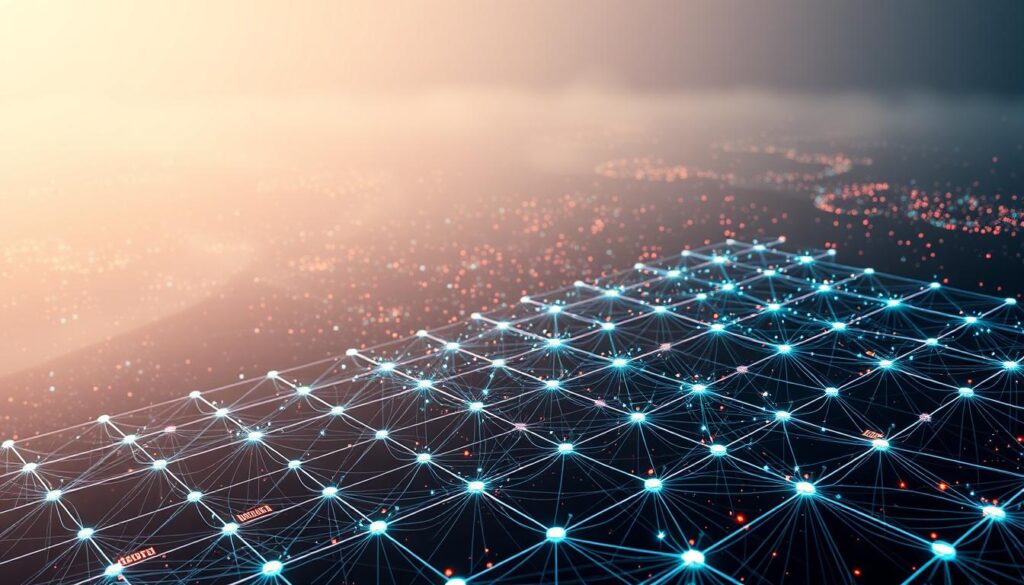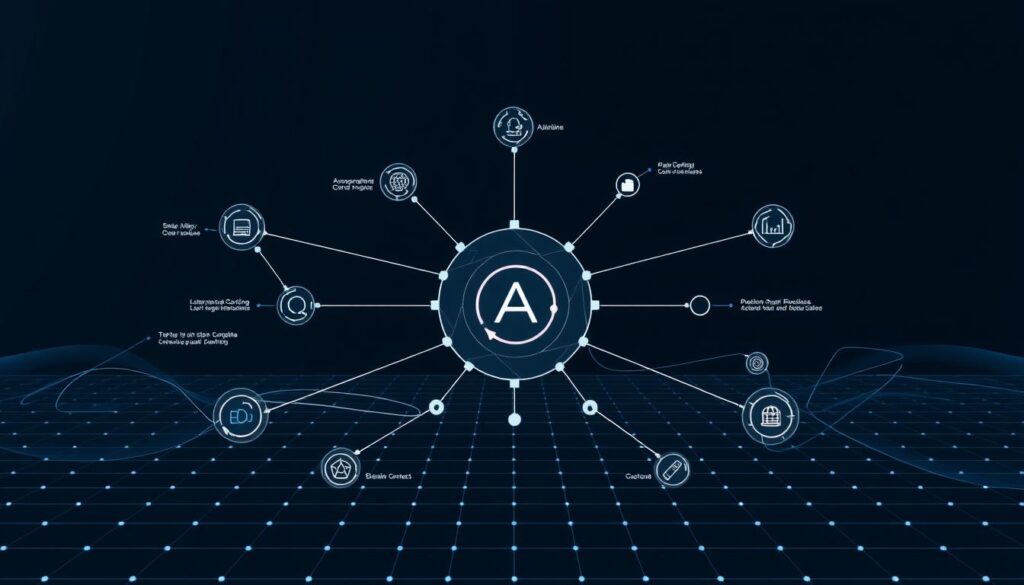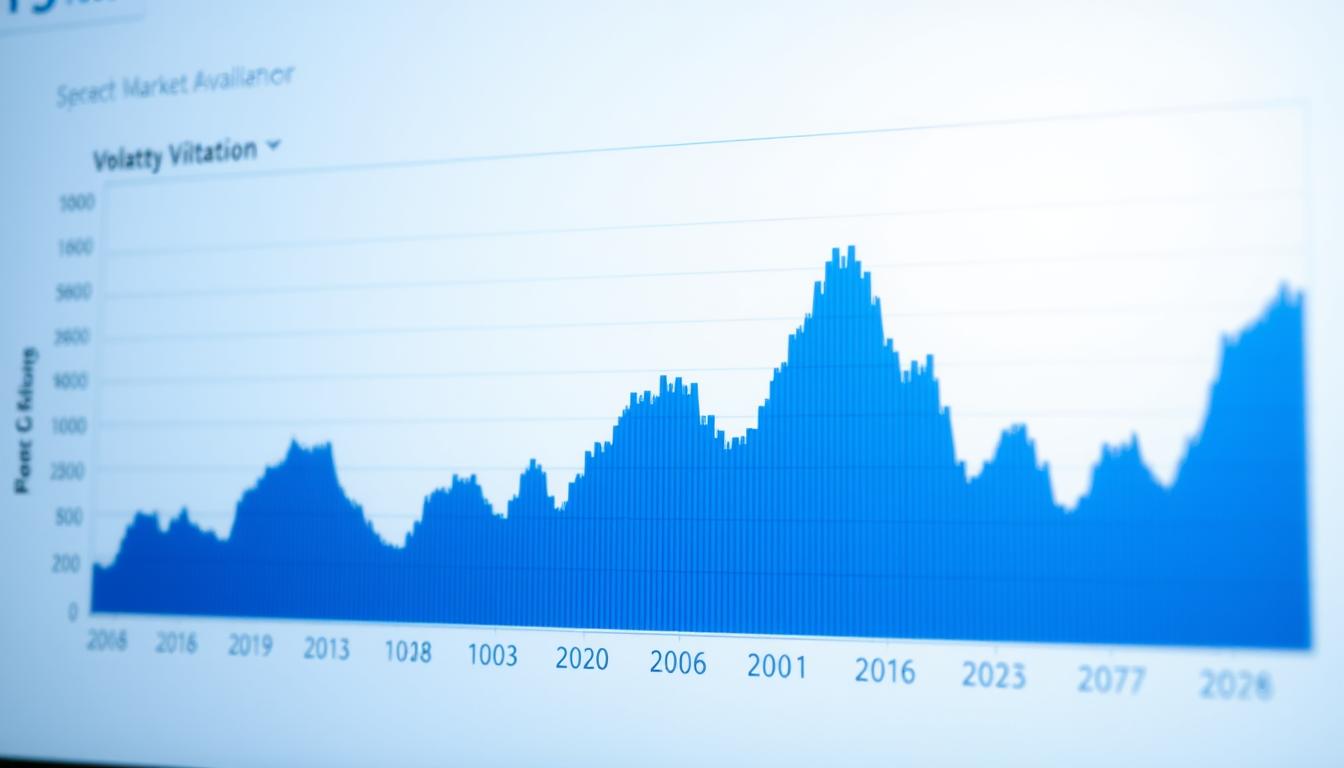Now Reading: Blockchain Bridge Cross Chain TransferBlockchain Oracle Real World Data
- 01
Blockchain Bridge Cross Chain TransferBlockchain Oracle Real World Data
Blockchain Bridge Cross Chain TransferBlockchain Oracle Real World Data

Digital ledgers operate in a sealed environment. They cannot naturally pull in facts from outside their own network. This creates a big problem for automated agreements that need outside details to work.
Special services, known as oracles, solve this issue. They act as a secure link between the sealed digital world and external systems. These services fetch and verify information from the outside.
This connection allows for powerful hybrid applications. Code on the ledger can now work with off-chain infrastructure. The result is programs that can react to actual events and work with traditional systems.
The importance of these services is immense. They maintain the core security of the digital ledger while enabling new uses. This expands possibilities far beyond simple transactions.
Key Takeaways
- Digital ledgers are isolated and cannot access external facts on their own.
- Oracles provide a critical link to outside information and legacy systems.
- This connection enables the creation of advanced hybrid applications.
- Decentralized networks of these services help maintain security and trust.
- The technology expands use cases for automated agreements significantly.
- It allows different digital ledgers and traditional systems to work together.
Introduction
Programmable agreements that run automatically encounter a fundamental architectural constraint. These smart contracts execute precisely when specific conditions occur, but they operate within isolated computational environments.
The deterministic nature of these systems provides security benefits but creates significant barriers. They cannot directly pull information from external sources like APIs or real-world events.
This limitation creates what’s known as the oracle problem. Consider two people making a sports bet using a digital contract. The agreement needs accurate game results to settle properly.
The core challenge involves maintaining security while accessing outside data. This fundamental problem must be solved for smart contracts to reach their full potential across various industries.
The Role of Oracles in Blockchain Ecosystems
The true power of self-executing contracts lies in their ability to interact with information beyond their native environment. These automated agreements need a reliable way to bring in facts from the outside. This is where specialized services, known as oracles, become essential.
They act as a trusted link, fetching and verifying external details. This process allows code on the ledger to react to actual happenings.

Overcoming the Oracle Problem
Early solutions relied on single sources for information. This created a weak point, as one failure could disrupt an entire system. A more robust approach was needed to maintain security.
The modern solution involves a network of independent operators. These nodes pull data from multiple sources. They then use a consensus mechanism to agree on the correct information before sending it to the contracts.
This method prevents manipulation and ensures accuracy. It effectively solves the core challenge of accessing off-chain details securely.
Benefits of Decentralized Oracle Networks
Using a distributed group of nodes offers significant benefits. Redundancy means the system has no single point of failure. If one node goes offline, others continue to provide service.
Consensus among operators improves the reliability of the information delivered. This structure also increases the overall uptime and resilience of the service.
For instance, a weather-based agreement can trust the temperature reading it receives. This enables complex smart contracts that depend on real-world events.
Blockchain Bridge Cross Chain Transfer Blockchain Oracle Real World Data Essentials
Third-party services play a crucial role in bringing external reality into isolated computational environments. These specialized components fetch and verify facts from outside sources, enabling automated agreements to interact with real-world conditions.
Definition and Core Concepts
An oracle acts as a secure messenger between off-chain systems and on-chain code. It follows specific protocols to gather, validate, and deliver information. This process ensures that self-executing agreements receive accurate inputs.
The technical architecture involves multiple validation steps. Data passes through several security checks before reaching its destination. This prevents incorrect information from affecting contract outcomes.
Translation between different data formats is another essential function. Oracles convert external information into a structure that smart contracts can understand. This interoperability is fundamental for complex applications.
Importance in Decentralized Applications
These services unlock practical use cases across finance, insurance, and gaming. Without them, automated agreements would be limited to simple token movements. The technology expands their capabilities significantly.
Accuracy is critically important because the delivered information directly determines contract results. A single error can lead to substantial value being transferred incorrectly. This highlights the “garbage in, garbage out” principle in digital ecosystems.
Different applications require tailored security models. High-value agreements need more robust validation mechanisms. The flexibility of oracle systems supports various risk profiles and use cases.
Smart Contract Integration with Real-World Data
The technical connection between automated agreements and external facts requires careful engineering. Specialized components fetch and verify information from outside sources for use by self-executing code.

Data Acquisition and Validation Processes
These systems use different methods to obtain information. Some push updates automatically at set times. Others wait for specific requests from the code.
Intermediate contracts act as secure storage points. They receive, hold, and distribute external facts to applications that need them. This creates a reliable pipeline for information flow.
Raw data undergoes conversion into standardized formats. This translation allows automated agreements to understand and process the inputs correctly. Proper formatting ensures compatibility between different systems.
Validation protocols provide security through cryptographic proofs. Digital signatures confirm source authenticity. Special proofs verify large datasets efficiently without revealing sensitive details.
Cross-checking compares inputs from multiple independent providers. Statistical analysis identifies unusual patterns or potential manipulation. Time-based checks filter outdated information.
These layered processes ensure that self-executing agreements receive accurate, current facts. The integration enables complex logic based on external conditions while maintaining system security.
Types of Blockchain Oracles and Their Functions
Oracle systems come in various forms to handle distinct data requirements. Each type serves specific purposes in decentralized applications.

Input and Output Oracles
Input oracles fetch information from external sources for smart contracts. They pull details like financial market prices or weather conditions.
Output oracles perform the reverse function. They allow contracts to trigger actions in traditional systems like banking networks.
Hardware vs. Software Oracles
Software oracles interface with digital sources through APIs and web services. They provide real-time market data and online information efficiently.
Hardware oracles use physical sensors to collect environmental data. These devices monitor temperature, location, or biometric information directly.
Cross-Chain and Compute-Enabled Oracles
Cross-chain oracles enable interoperability between different networks. They facilitate seamless information sharing across multiple environments.
Compute-enabled oracles perform complex calculations offchain. This includes generating proofs or running randomness functions impractical for onchain execution.
Security Considerations for Oracle Networks
Sophisticated security frameworks are essential for maintaining trust in external data providers. These systems face various threats that could compromise information accuracy.
Protection mechanisms must address multiple attack vectors simultaneously. This ensures reliable operation for automated agreements.

Mitigating Trust Centralization
Distributed architectures eliminate single points of failure. Multiple independent operators provide redundancy and resistance to manipulation.
Reputation tracking helps identify reliable information sources. Nodes with consistent performance gain higher standing over time.
| Security Mechanism | Primary Function | Key Benefit |
|---|---|---|
| Multiple Data Sources | Cross-verify information | Eliminates single source risk |
| Time Delays | Prevent rapid manipulation | Protects against flash attacks |
| Circuit Breakers | Pause during anomalies | Automatic protection |
| Staking Requirements | Financial commitment | Incentivizes accuracy |
Leveraging Consensus Mechanisms
Network participants use various validation methods to ensure data integrity. These approaches combine multiple inputs for reliable results.
Services like Chainlink implement advanced consensus protocols. These systems aggregate information from numerous providers.
Economic incentives align node behavior with network security. Operators risk financial penalties for poor performance.
Cross-Chain Transfer Mechanisms and Interoperability
The ability to exchange information across different environments unlocks unprecedented functionality. Specialized infrastructure enables coordinated operations between distinct computational spaces.
Seamless Data Flow Across Blockchains
Modern applications increasingly demand communication between previously isolated platforms. This requires sophisticated mechanisms that can securely move digital assets and information.
These systems monitor activities on multiple networks simultaneously. They coordinate transfers between different environments while maintaining security protocols.
Enterprise solutions benefit greatly from this technology. Companies can connect their backend operations to various networks through a single interface. This eliminates the need for separate integrations for each platform.
| Transfer Method | Primary Function | Key Advantage |
|---|---|---|
| Lock and Mint | Asset movement between networks | Preserves original asset security |
| Atomic Swaps | Peer-to-peer exchanges | No intermediary required |
| Relay Chains | Information broadcasting | Scalable multi-network communication |
| Middleware Bridges | Enterprise system integration | Simplified backend connections |
Price information flows smoothly across networks through these mechanisms. Applications gain access to comprehensive market data from multiple sources. This enables more accurate valuation and trading decisions.
The evolution of distributed ledger technology continues to expand interoperability capabilities. As these systems mature, they create more connected ecosystems where resources can move freely while maintaining security standards.
Conclusion
As the digital ecosystem matures, the critical infrastructure connecting on-chain logic with off-chain reality continues to demonstrate its indispensable value. Established networks like Chainlink price feeds already secure billions in value across various applications.
The technology enables diverse use cases from DeFi applications requiring accurate asset valuations to insurance contracts verifying weather events. Supply chain tracking and sports betting markets also rely on these essential services.
Looking ahead, the evolution of these networks focuses on balancing decentralization with practical usability. This infrastructure remains fundamental for smart contracts to reach their full potential by bridging isolated computational environments with external information.
FAQ
What is a decentralized oracle network?
A decentralized oracle network is a system that securely fetches information from external sources, like price feeds or weather data, and delivers it to smart contracts on a blockchain. This setup helps avoid a single point of failure, making the data more reliable for applications like DeFi.
Why do smart contracts need oracles?
Smart contracts operate with predefined rules but cannot access real-world events or data on their own. Oracles act as a bridge, providing essential information such as asset prices or sports scores, enabling contracts to execute based on real-time conditions.
What is the oracle problem?
The oracle problem refers to the challenge of trusting data coming from outside a blockchain. If the data source is compromised, the smart contract’s outcome can be manipulated. Decentralized networks mitigate this by using multiple independent nodes to verify information.
How do cross-chain transfers work with oracles?
Cross-chain transfers allow assets or information to move between different blockchains. Oracles can facilitate this by verifying events on one chain and triggering actions on another, enabling interoperability and seamless data flow across diverse systems like Ethereum and Polygon.
What are the main types of oracles?
The primary types include input oracles (bringing data in), output oracles (sending data out), software oracles (for online data), and hardware oracles (for physical world data). Compute-enabled oracles can also perform off-chain computations for complex tasks.
How is security maintained in oracle networks?
Security is maintained through decentralization and consensus mechanisms. Networks like Chainlink use numerous independent nodes and reputation systems to validate data. This reduces the risk of tampering and ensures the integrity of the information supplied to contracts.















